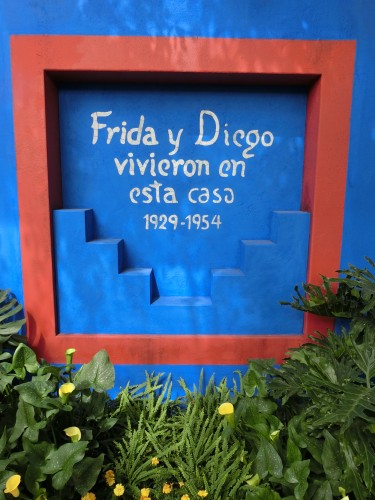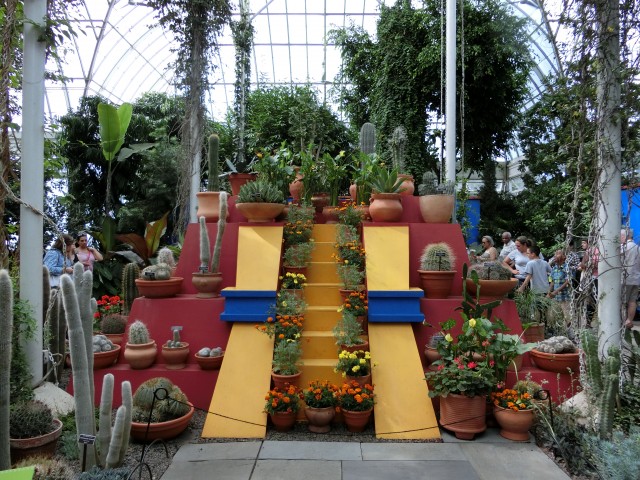
New York Botanical Garden re-creates Frida Kahlo and Diego Rivera’s Casa Azul studio and garden (photo by twi-ny/mdr)
The New York Botanical Garden
Enid A. Haupt Conservatory
2900 Southern Blvd., Bronx
Tuesday – Sunday through November 1, $8-$25
718-817-8700
www.nybg.org/frida
frida kahlo: art garden life slideshow
Don’t let the cold weather scare you away from seeing the New York Botanical Garden’s beautiful celebration of Mexican painter Frida Kahlo’s passionate relationship with the natural world. “Frida Kahlo: Art, Garden, Life,” on view at the Bronx institution through November 1, is a wide-ranging tribute to the artist, including paintings, photographs, a historical timeline, a re-creation of her garden and studio, known as La Casa Azul, and special programs. “When we began to research Frida Kahlo, we wanted to delve into the story of the woman who has been examined through her pain and suffering and paint her in a different light,” NYBG associate vice president of exhibitions and public engagement Karen Daubmann writes in her catalog essay, “Making Frida Kahlo’s Garden in New York: The Conservatory Exhibition.” She continues, “We wanted to learn more about the iconic face that is emblazoned on canvases, the strong and fierce-looking dark-haired, dark-eyed woman who used to be known as Diego Rivera’s wife and is now known simply as Frida. The more we researched, the more intrigued we became. . . . We were fascinated by the incredible detail of Kahlo’s curated life.” That curated life is lovingly explored in the exhibition, which features fourteen of the artist’s paintings in the LuEsther T. Mertz Library’s art gallery, including “Portrait of Luther Burbank,” in which Kahlo depicts the famed botanist emerging from the root of a tree; the vulvic “Sun and Life”; “Two Nudes in the Forest,” which was originally called “The Earth Itself”; and the sensational “Self-Portrait with Thorn Necklace and Hummingbird,” in which Kahlo, in between her first and second marriages to Rivera, paints herself surrounded by flowers, a dead hummingbird, a monkey, butterflies, and a black cat, a symbolic representation of life, death, and rebirth. The path to the next part of the show, in the Enid A. Haupt Conservatory, is lined with poems by Nobel Prize–winning Mexican poet Octavio Paz, including “The Religious Fig” and “Nightfall.” Paz was in fact not a big fan of Kahlo’s and Rivera’s; “Diego and Frida ought not to be subjects of beatification but objects of study — and of repentance . . . the weaknesses, taints, and defects that show up in the works of Diego and Frida are moral in origin,” Paz wrote in Essays on Mexican Art. “The two of them betrayed their great gifts, and this can be seen in their painting.”
The centerpiece of the exhibition is La Casa Azul, a reconstruction of Kahlo’s studio and garden at her family home in Mexico City, which is now a museum. The conservatory is filled with folk art objects, religious ex-voto paintings, Mexican plants described in both English and Spanish (and inspired by archival photographs), and re-creations of the Frog Fountain with its mosaic floor, Kahlo’s desk and easel, and the strikingly colorful Casa Azul pyramid, holding dozens of Mexican cacti and succulents. The conservatory exhibition was designed by Scott Pask, the three-time Tony-winning designer of The Book of Mormon, The Coast of Utopia, and The Pillowman. Outside the conservatory, by the lily pond, is a fence of organ pipe cacti, like the one Kahlo had at her San Ángel house. “Frida Kahlo: Art, Garden, Life” immerses you in the world of this fascinating artist, who passed away in 1954 at the age of forty-seven. In conjunction with the exhibition, the NYBG is hosting special programming through closing day. On Saturdays and Sundays at 1:00, there is live music and dance in Ross Hall and throughout the garden, with performances by such groups as Mexico Beyond Mariachi, the Villalobos Brothers, Flor de Toloache, and Calpulli Danza Mexicana. “Cooking with Frida” takes place in the Ruth Rea Howell Family Garden on Wednesdays, Saturday, and Sundays at 2:00 & 4:00. The daily “Frida’s Fall Harvest” consists of family-friendly activities in the Everett Children’s Adventure Garden, including a puppet show and playhouse kitchen; the children’s garden will be open till 9:30 on October 23 for “Frida for Families: A Spooky Nighttime Adventure.” Also daily (but not for kids), “Spotlight on Agave: A Tequila Story” presents the history and tradition of the Mexican spirit. October 22 is “Frida al Fresco Evening” LGBT Night, with live music, stilt dancers, and Mexican food and drink. On October 24-25 and October 31 – November 1, things get scary with Día De Los Muertos Weekends, featuring skeletal processions, stilt dancers, skull face painting, and more. The “¡Cámara, Acción!” film series continues on Sundays at 3:00 in Ross Hall with Alonso Ruiz Palacios’s Güeros on October 25 and Francisco Franco’s Last Call on November 1. Also on November 1, there will be a live performance by two male models interacting with Humberto Spíndola’s “Two Fridas” sculptural installation, based on Kahlo’s 1939 double portrait in which two versions of her sit next to each other, holding hands.
